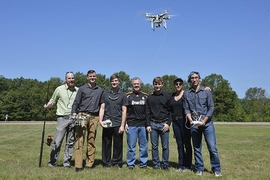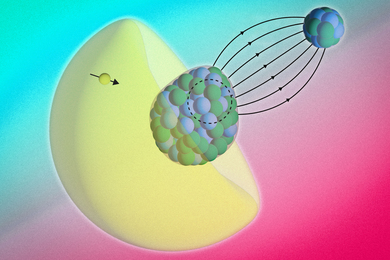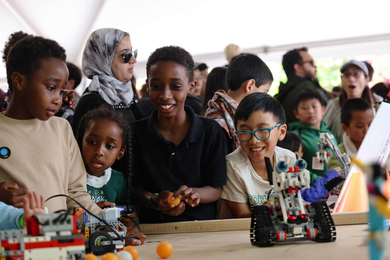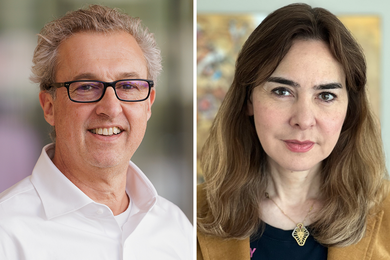People walking by MIT's Building 9, formally named the Samuel Tak Lee Building in Cambridge, Massachusetts, pause to contemplate the white plastic structure that appears to be part bench and part tower. Is it a new architecture-inspired sculpture? The campus is known to showcase outdoor art installations. Perhaps it is a public seating area? Wait, why is there a computer-like screen mounted in the tower section? Curious folks who take a minute to stop notice a giant quick-response (QR) code on one face of the rectangular bench, aim their cellphones at the image, and follow the code to a website that tells them this unit, a PREPHub, contains amenities for short-term responses to emergencies.
The PrepHub, a project of MIT's Urban Risk Lab, seeks to increase preparedness for crises such as hurricanes that disrupt a city's functioning. Led by Miho Mazereeuw, an assistant professor of architecture and the director of the Urban Risk Lab, the project is the demonstration of a completely off-grid facility that could help a city provide post-emergency services to citizens.
"The Urban Risk Lab has been researching the overlap of public open space use and disaster evacuation, especially in seismic regions, for over a decade," says Mazereeuw. "By understanding the specific post-disaster infrastructural needs for such spaces, we have been working on this idea of a dual-use community space to increase resilience to crises."
In the current PREPHub model, for example, a pedaled generator will enable people to recharge batteries or cellphones; an embedded webcam will let people take "selfies" and send those snapshots to relatives and social media services as evidence of their well-being; and an annunciation system can alert people to dangers or direct them to a shelter. "The ultimate goal is to have a network of PREPHubs in any disaster-vulnerable city that wants one, with hubs close enough together for anyone to be able to walk to one within 10 minutes," says Mazereeuw.
The PREPHub at Building 9 is the second hub built; a smaller model sits across the street in front of the student center. Mazereeuw and her MIT colleagues have over the past few months partnered with Lincoln Laboratory researchers to develop technology for enabling PREPHub services and to investigate future technologies for expanding PREPHub's capabilities. For the PREPHub, the laboratory has supplied a range of devices: the electrical subsystem, computer controls, a screen with camera-capture capability and a Twitter-connected "check-in" app to inform others of one's status, a basic communication system, interior lights, a dynamic evacuation map, and LED lights that indicate the pace and duration of the pedaling that is powering the generator.
"Rapidly constructing these two PREPHubs, which serve as both publicly accessible prototypes and test beds for future development, was an intense process," says Adam Norige, assistant leader of Lincoln Laboratory's Humanitarian Assistance and Disaster Relief Systems Group, who, along with technical staff members Brice MacLaren, Christopher Budny, Andrew Weinert, Peter Klein, Thomas Smith, and Ed Orchanian, is working on the PREPHub with the MIT Urban Risk Lab team.
"Getting the electronics working wasn't challenging from a 'know-how' perspective," Norige explains. "This work was relatively straightforward for the Lincoln Laboratory team. But, rapidly integrating the electrical subsystems, preserving the architectural aesthetics and principles, and ensuring the prototype could withstand unsupervised public use required a great deal of coordination and synergy between the architectural and engineering teams."
MacLaren expanded on those challenges: "The lights used a new electronics that had to be driven by software differently from what was advertised. Because we couldn't find this out until we had the system in front of us, we had to quickly write new code that controlled the board the way we wanted. The PREPHub's sectional design led to our having to connect the lights in a way not anticipated; we had to restructure our code for controlling those lights also."
"The campus PREPHub design is a prototype on which we can try out ideas. The laboratory has several significant capabilities that we plan to explore through the PREPHubs. Some of these capabilities might offer completely new approaches to aspects of disaster relief, such as urban search and rescue and communications with and for survivors," Norige says. "For example, we will be exploring advanced communication technologies, such as wireless networks, as alternatives to cell technology and as ways to funnel information among hubs."
Ideas are diverse for future PREPHub features that Lincoln Laboratory could help create. One idea is to use the laboratory's experience with lidar imaging systems to develop sensors that could create visuals of the street conditions around a PREPHub, perhaps showing if nearby streets are navigable or rubble-strewn. Another future activity may be researching novel schemes for off-grid power to supplement the solar energy provided by panels in the tower section of the PREPHub. Adding processing units to the hub could allow first responders to use the facility as a sort of field command center.
"Working with the talented and dedicated Lincoln Laboratory team that approaches some of our same problems from different angles has opened up a lot of new avenues in our thinking about the project," says Mazereeuw. "We have always considered the PREPHub a flexible platform for a number of technologies related to building disaster resilience and post-disaster recovery. Working with the laboratory has greatly expanded our thinking on what could be possible, from wireless mesh networking between hubs to remote sensing tools for first responders."
The PREPHubs are also envisioned as community resources during ordinary times. "As PREPHubs will be deployed in communities before a disaster, it is imperative that each important post-disaster function be useful in everyday scenarios. This everyday use will communicate the post-disaster functionality, making sure that the hubs are well known, well used, and well maintained landmarks all the time, allowing them to perform when needed the most after a disaster strikes," says Mazereeuw.
The L-shaped layout of the white campus hubs is just one design variation; an architect could imagine uniquely configured hubs that not only accommodate emergency services but also the desires of the residents in a PREPHUb zone. For example, a set of units could compose a meeting space for a neighborhood of mainly single-occupancy apartments, or a fanciful array of structures might serve as a playground in an area where many children live.
The larger PREPHub was installed on April 22, the night before MIT's Open House event that celebrated the Institute's 100th year in Cambridge. MacLaren said that before they had completed the unit at 1:15 a.m., people were stopping to examine it. And why not? The interior blue LED lights illuminate the hub into a glowing structure. At the Open House, interest continued: Open House began at 10 a.m. Saturday morning, and by 10:05, people were already scanning the QR code.
"When we started this project, a member of the Urban Risk Lab team was asked what he wanted people to think when they saw the hub. He said he wanted people to know 'that architecture could be functional and delightful,'" says MacLaren. "He was standing next to me when we turned the lights on for the first time and he just very slowly said, 'It’s so beautiful.'"
The next steps in realizing the PREPHub vision are to extend the services provided by the units and to interest urban communities in the concept of a web of hubs useful for citizens both before and after a disaster. To that end, Lincoln Laboratory is researching how technologies in which it has deep experience can be utilized aboard a hub, and the Urban Risk Lab is connecting with San Francisco to install a prototype there.










